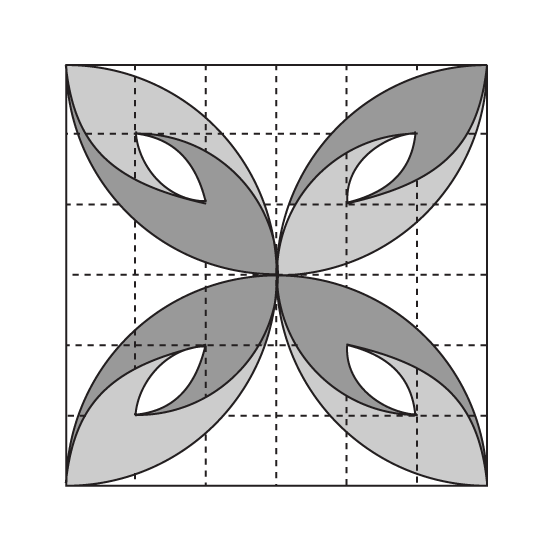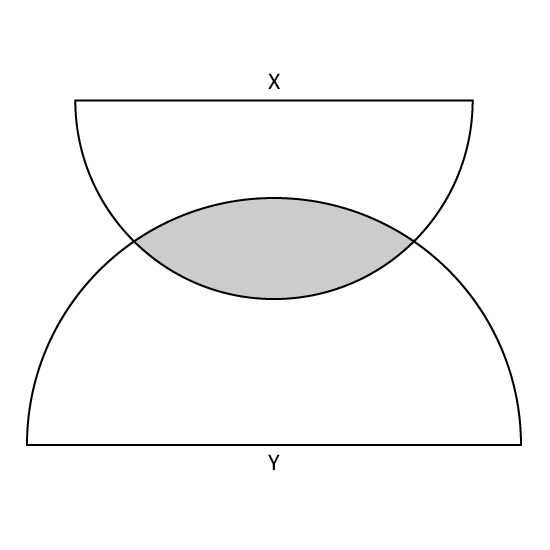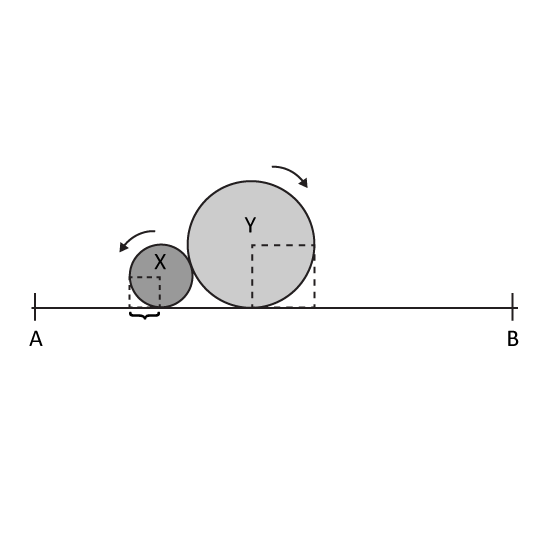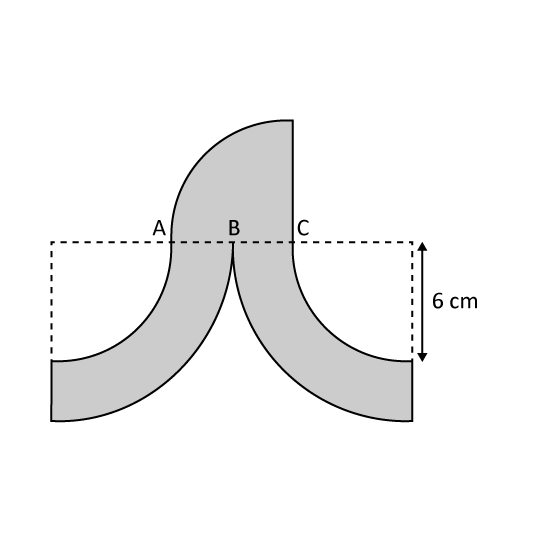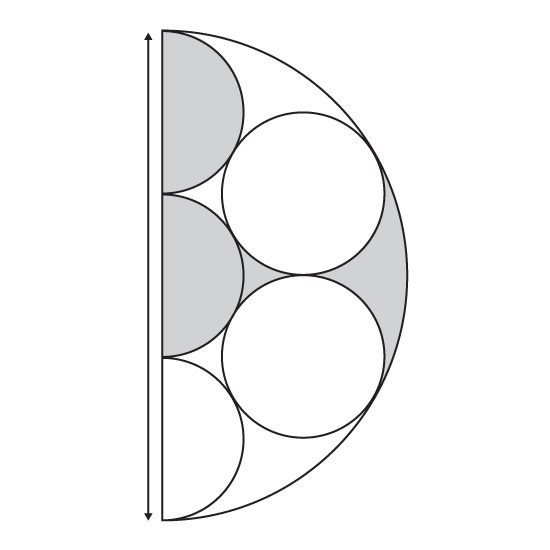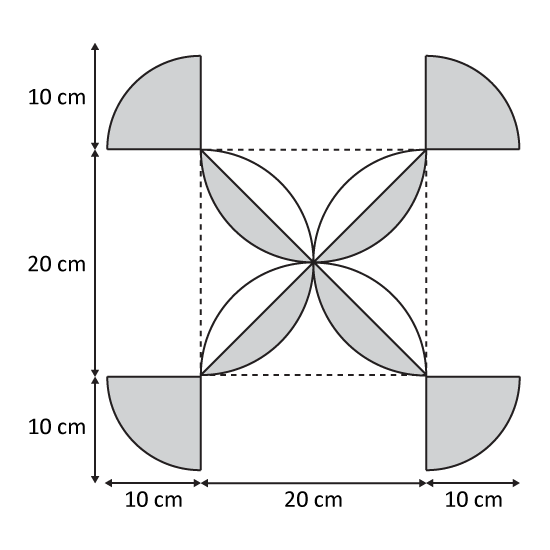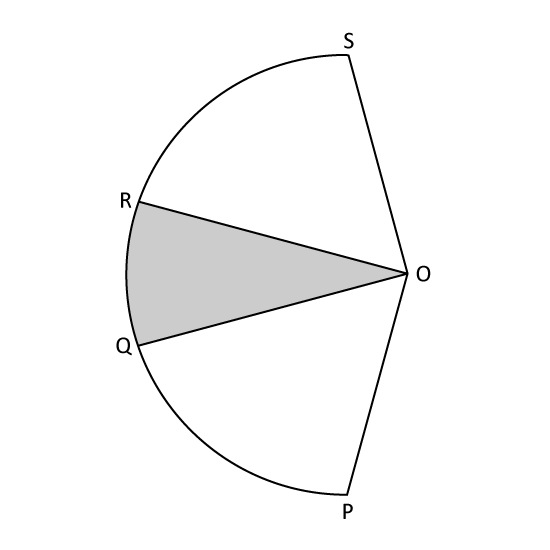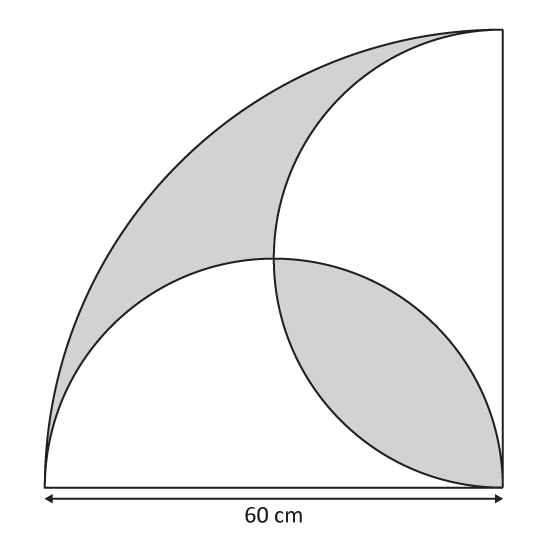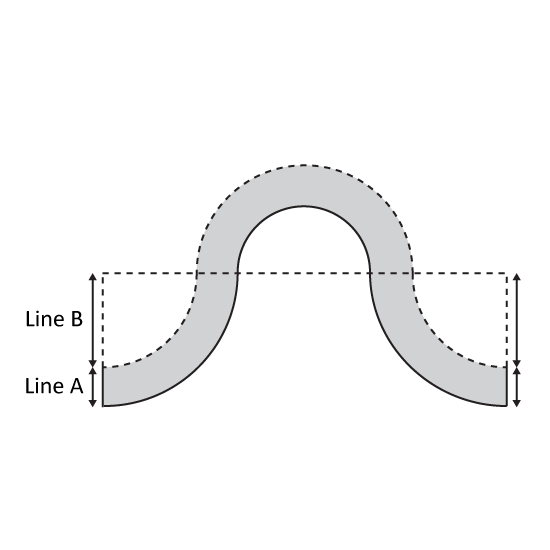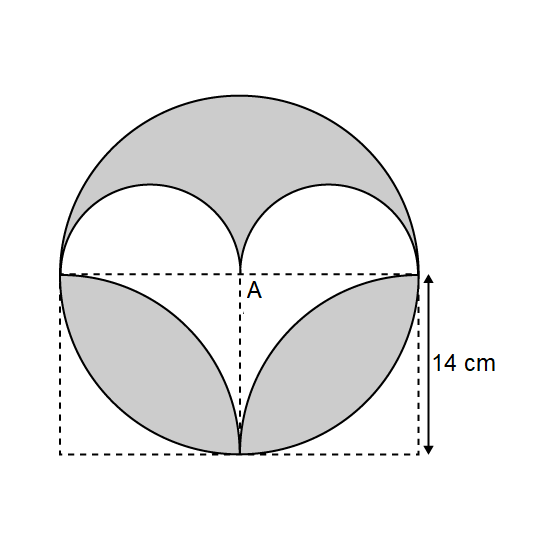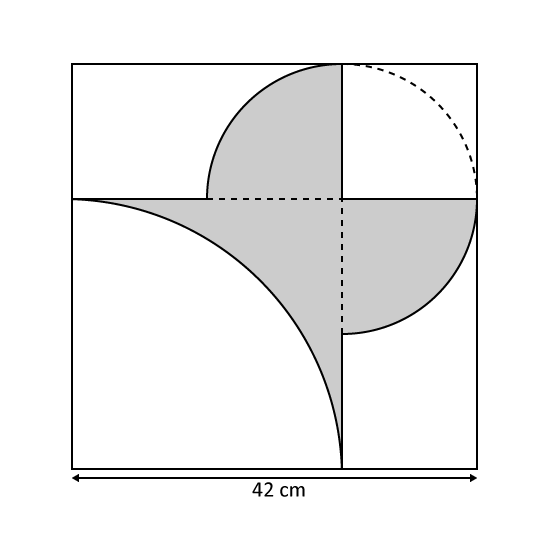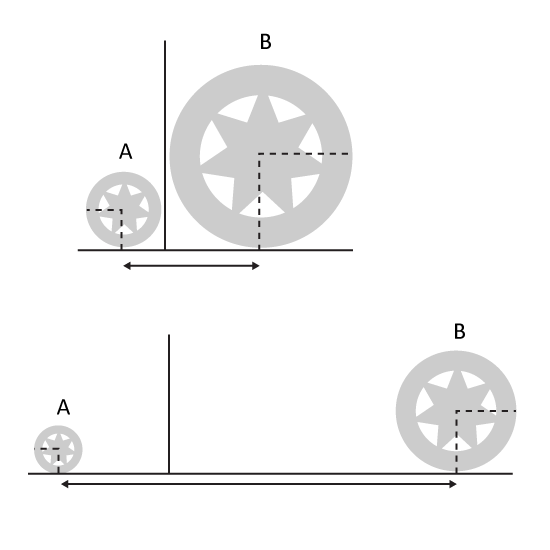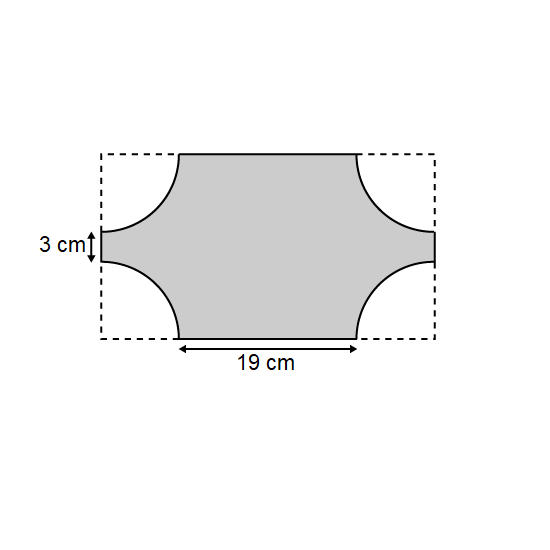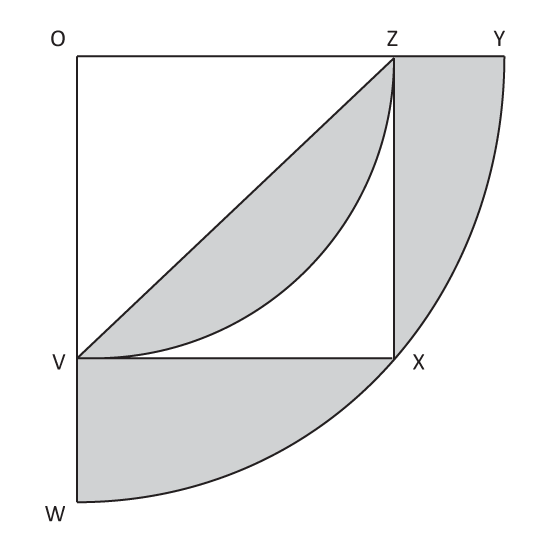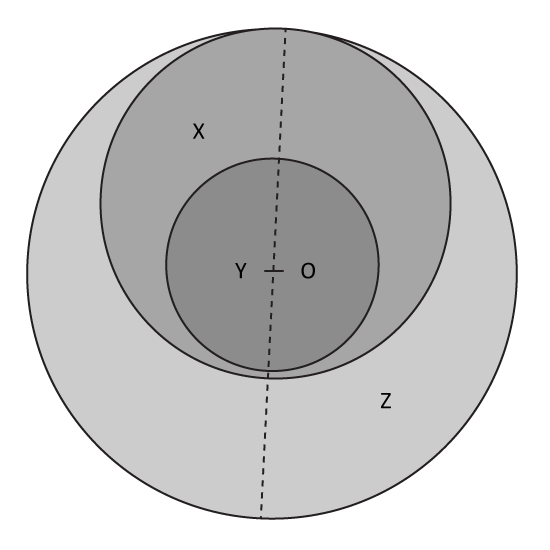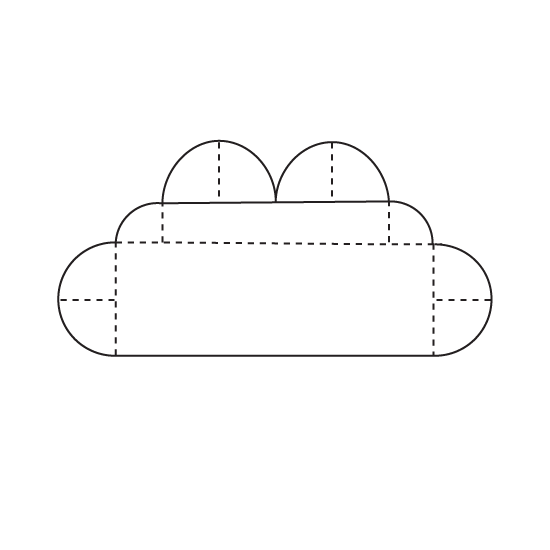Level 3
The figure is made up of curved lines (arcs) of quadrants with radius of different lengths in a square of edge 6 cm. Find the total shaded area. (Take π = 3.14)
Level 3
The figure is made up of curved lines (arcs) of quadrants with radius of different lengths in a square of edge 6 cm. Find the total shaded area. (Take π = 3.14)
Image in this question is not available.
Level 3
The figure is not drawn to scale. It is made up of 2 semicircles, X and Y, overlapping each other. The radius of semicircle X is 7 cm while the radius of semicircle Y is 14 cm. 37 of semicircle X is shaded. What fraction of the whole figure is not shaded? Express the answer in the simplest form. (Take π = 227)
Level 3
The figure is not drawn to scale. It is made up of 2 semicircles, X and Y, overlapping each other. The radius of semicircle X is 7 cm while the radius of semicircle Y is 14 cm. 37 of semicircle X is shaded. What fraction of the whole figure is not shaded? Express the answer in the simplest form. (Take π = 227)
Image in this question is not available.
Level 3
The figure is not drawn to scale. Two balls, X and Y, turn and move along the line AB in opposite directions. The radius of X is 10 cm. The ratio of the diameter of Ball X to that of Ball Y is 5 : 2. If Ball X turns 10 rounds and Ball Y turns 2 rounds, how far apart are the centres of the balls?
(Take π = 3.14)
Level 3
The figure is not drawn to scale. Two balls, X and Y, turn and move along the line AB in opposite directions. The radius of X is 10 cm. The ratio of the diameter of Ball X to that of Ball Y is 5 : 2. If Ball X turns 10 rounds and Ball Y turns 2 rounds, how far apart are the centres of the balls?
(Take π = 3.14)
Image in this question is not available.
Level 2 PSLE The outline of the shaded figure is formed by 3 identical small quarter circles, 2 identical large quarter circles and 3 straight lines. Take π = 3.14
- What is the radius of the large quarter circle?
- Find the perimeter of the shaded figure.
Level 2 PSLE The outline of the shaded figure is formed by 3 identical small quarter circles, 2 identical large quarter circles and 3 straight lines. Take π = 3.14
- What is the radius of the large quarter circle?
- Find the perimeter of the shaded figure.
Image in this question is not available.
Level 3
A piece of rope is used to make the figure shown. Inside the big semicircle are 2 small circles and 3 small semi-circles, all of which have the same radius. The diameter of the big semicircle is 30 cm. Find the area of the shaded region. (Leave the answer in terms of π)
Level 3
A piece of rope is used to make the figure shown. Inside the big semicircle are 2 small circles and 3 small semi-circles, all of which have the same radius. The diameter of the big semicircle is 30 cm. Find the area of the shaded region. (Leave the answer in terms of π)
Image in this question is not available.
Level 3
The figure is made up of identical quadrants. The radius is 10 cm long. Take π as 3.14.
- Find the area of the shaded part.
- Find the perimeter of the shaded part.
Level 3
The figure is made up of identical quadrants. The radius is 10 cm long. Take π as 3.14.
- Find the area of the shaded part.
- Find the perimeter of the shaded part.
Image in this question is not available.
Level 3 PSLE
OPQRS is part of a circle of radius 10 cm. OPR and OQS are quarter circles. The area of the shaded part OQR is 40 cm
2 and the perimeter of the shaded part OQR is 30 cm. For each of the following, use the calculator value of π to find:
- the area of the figure OPQRS, correct to 2 decimal places,
- the perimeter of the figure OPQRS, correct to 1 decimal places.
Level 3 PSLE
OPQRS is part of a circle of radius 10 cm. OPR and OQS are quarter circles. The area of the shaded part OQR is 40 cm
2 and the perimeter of the shaded part OQR is 30 cm. For each of the following, use the calculator value of π to find:
- the area of the figure OPQRS, correct to 2 decimal places,
- the perimeter of the figure OPQRS, correct to 1 decimal places.
Image in this question is not available.
Level 3
The figure shows one big quadrant and two small semicircles. The radius of the big quadrant is 60 cm.
- Find the perimeter of the shaded figure. (Take π = 3.14)
- Find the shaded area of this figure. (Take π = 3.14)
Level 3
The figure shows one big quadrant and two small semicircles. The radius of the big quadrant is 60 cm.
- Find the perimeter of the shaded figure. (Take π = 3.14)
- Find the shaded area of this figure. (Take π = 3.14)
Image in this question is not available.
Level 3
The figure is not drawn to scale. It is formed by quadrants and semicircles of two sizes. The radius of the larger quadrant is 3 cm longer than the radius of the smaller quadrant. The radius of the smaller quadrant (Line B) is 12 cm.
- Find the area of the shaded part.
- Find the perimeter of the dotted line. (Take π = 3.14)
Level 3
The figure is not drawn to scale. It is formed by quadrants and semicircles of two sizes. The radius of the larger quadrant is 3 cm longer than the radius of the smaller quadrant. The radius of the smaller quadrant (Line B) is 12 cm.
- Find the area of the shaded part.
- Find the perimeter of the dotted line. (Take π = 3.14)
Image in this question is not available.
Level 3 PSLE The figure is made up of 6 identical quadrants and 2 identical semicircles. The radius of each quadrant is 14 cm.
The unshaded area marked A is enclosed by 2 quadrants and 2 semicircles. (Take π = 3.14)
- Find the perimeter of A.
- Find the total shaded areas.
Level 3 PSLE The figure is made up of 6 identical quadrants and 2 identical semicircles. The radius of each quadrant is 14 cm.
The unshaded area marked A is enclosed by 2 quadrants and 2 semicircles. (Take π = 3.14)
- Find the perimeter of A.
- Find the total shaded areas.
Image in this question is not available.
Level 3 PSLE Tom designed a logo as shown. The logo is made up of 2 small identical quarter circles, a large quarter circle and 2 straight lines drawn inside a square of side 42 cm. The radius of each small quarter circle is 14 cm.
- What is the perimeter of the shaded part?
- What is the area of the shaded part?
Level 3 PSLE Tom designed a logo as shown. The logo is made up of 2 small identical quarter circles, a large quarter circle and 2 straight lines drawn inside a square of side 42 cm. The radius of each small quarter circle is 14 cm.
- What is the perimeter of the shaded part?
- What is the area of the shaded part?
Image in this question is not available.
Level 3
This figure is not drawn to scale. Wheel A and Wheel B are touching a vertical plastic sheet. The ratio of the radius of the small wheel A to the radius of the big wheel B is 2 : 5. The total radii of Wheel A and Wheel B is 196 cm. Both wheels are rolled out in opposite direction shown until they are 2660 cm apart. The two wheels need to make the same number of revolutions. How many revolutions does each wheel make assuming that each wheel must make a complete revolution? (Take π = 227)
Level 3
This figure is not drawn to scale. Wheel A and Wheel B are touching a vertical plastic sheet. The ratio of the radius of the small wheel A to the radius of the big wheel B is 2 : 5. The total radii of Wheel A and Wheel B is 196 cm. Both wheels are rolled out in opposite direction shown until they are 2660 cm apart. The two wheels need to make the same number of revolutions. How many revolutions does each wheel make assuming that each wheel must make a complete revolution? (Take π = 227)
Image in this question is not available.
Level 3 The figure shows a rectangle with its corners cut out. Each of the 4 identical corners cut out is a quarter circle. The ratio of the length of the rectangle to its breadth is 13 : 5.
- What is the radius of each quarter circle?
- What is the perimeter of the shaded part. Take π = 3.14. Give your answer correct to 1 decimal place.
Level 3 The figure shows a rectangle with its corners cut out. Each of the 4 identical corners cut out is a quarter circle. The ratio of the length of the rectangle to its breadth is 13 : 5.
- What is the radius of each quarter circle?
- What is the perimeter of the shaded part. Take π = 3.14. Give your answer correct to 1 decimal place.
Image in this question is not available.
Level 3
The figure is made up of a big quadrant OWY a small quadrant OVZ and a square VXZO. The radius of the big quadrant OWY is 12cm. The area of the big quadrant is twice the area of the small quadrant OVZ. Using the calculator value of π, find the area of the shaded parts, correct to 2 decimal places.
Level 3
The figure is made up of a big quadrant OWY a small quadrant OVZ and a square VXZO. The radius of the big quadrant OWY is 12cm. The area of the big quadrant is twice the area of the small quadrant OVZ. Using the calculator value of π, find the area of the shaded parts, correct to 2 decimal places.
Image in this question is not available.
Level 3
The figure is make up of 3 circles. The small circle has centre O and a radius of 6 cm. The big circle, has centre O and a radius of 10 cm. The diameter of the big circle cuts through the centre of the medium-sized circle and the small circle. The three regions formed are indicated as X, Y and Z.
- Find the radius of the medium-sized circle.
- Find the area of region Z. Use a calculator to obtain the value of π.
(Round off to nearest 2 decimal places).
- Express the area of the region Y as a ratio to the area of region X.
Level 3
The figure is make up of 3 circles. The small circle has centre O and a radius of 6 cm. The big circle, has centre O and a radius of 10 cm. The diameter of the big circle cuts through the centre of the medium-sized circle and the small circle. The three regions formed are indicated as X, Y and Z.
- Find the radius of the medium-sized circle.
- Find the area of region Z. Use a calculator to obtain the value of π.
(Round off to nearest 2 decimal places).
- Express the area of the region Y as a ratio to the area of region X.
Image in this question is not available.
Level 3 PSLE The figure shows a table cloth. The outside edge of the mat is formed by 4 semicircles and 2 quarter circles, each of radius 14 cm.
- Find the perimeter of the mat.
- Find the area of the mat. Take π = 227.
Level 3 PSLE The figure shows a table cloth. The outside edge of the mat is formed by 4 semicircles and 2 quarter circles, each of radius 14 cm.
- Find the perimeter of the mat.
- Find the area of the mat. Take π = 227.
Image in this question is not available.
Level 3 PSLE
A small circle with centre O has been cut from a circular piece of cardboard with the same centre. The radius of the small circle is 8 cm.
The remaining cardboard is then cut into four equal parts along the dotted lines as shown in Figure 1. The four parts are rearranged to form a new shape in Figure 2.
- Find the area of the new shape.
- Find the perimeter of the new shape. (Take π = 3.14)
Level 3 PSLE
A small circle with centre O has been cut from a circular piece of cardboard with the same centre. The radius of the small circle is 8 cm.
The remaining cardboard is then cut into four equal parts along the dotted lines as shown in Figure 1. The four parts are rearranged to form a new shape in Figure 2.
- Find the area of the new shape.
- Find the perimeter of the new shape. (Take π = 3.14)
Image in this question is not available.
